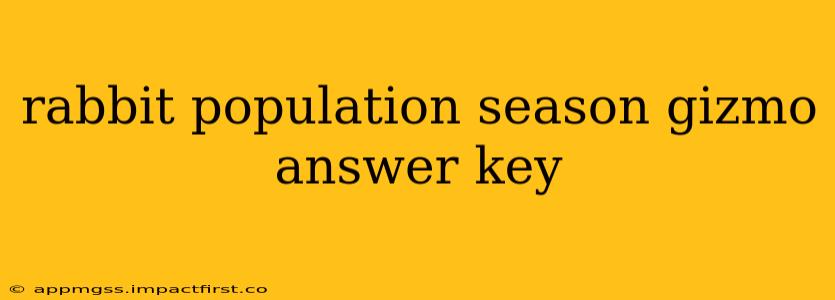Unlocking the Secrets of the Rabbit Population Gizmo: A Comprehensive Guide
The Rabbit Population Gizmo is a popular interactive simulation used in science classrooms to explore exponential growth and population dynamics. Understanding how to interpret the data and answer the questions correctly is key to mastering the concepts. This guide will provide you with a comprehensive understanding of the Gizmo, helping you unlock those answers and grasp the underlying principles. While I can't provide the exact answers from your specific Gizmo worksheet (as versions vary), I can equip you with the knowledge to derive those answers independently.
Understanding the Gizmo's Mechanics:
The Gizmo typically presents a simplified model of a rabbit population, allowing you to manipulate variables such as initial population size, birth rate, death rate, and carrying capacity. By altering these factors, you observe the impact on the population growth over time. The key to success lies in carefully observing the graphs and data tables generated by the simulation.
Common Gizmo Questions & How to Approach Them:
Many Gizmo assignments revolve around predicting population trends based on different parameter adjustments. Let's address some common question types:
What factors affect rabbit population growth?
This is a foundational question. The Gizmo highlights several key factors:
- Birth Rate: A higher birth rate leads to faster population growth.
- Death Rate: A higher death rate slows or even reverses population growth.
- Carrying Capacity: This represents the maximum population size the environment can sustainably support. Once the population approaches the carrying capacity, growth slows down significantly. Factors like food availability, space, and predators influence the carrying capacity.
- Initial Population: The starting number of rabbits significantly influences the subsequent population trajectory. A larger starting population will generally lead to a faster increase in numbers, assuming other factors are constant.
How does changing the birth rate affect the rabbit population?
Increasing the birth rate accelerates population growth, resulting in a steeper upward curve on the population graph. Conversely, decreasing the birth rate will slow down the growth, potentially leading to a plateau or even a decline if the death rate is higher.
How does changing the death rate affect the rabbit population?
Increasing the death rate will reduce population growth, potentially causing a population decline. A higher death rate might even lead to the extinction of the rabbit population if it exceeds the birth rate. Conversely, lowering the death rate will promote growth.
What is carrying capacity, and how does it affect the rabbit population?
Carrying capacity is the maximum number of rabbits the environment can sustainably support. As the population approaches the carrying capacity, resource scarcity (food, water, shelter) leads to increased competition and potentially higher death rates. This causes the growth rate to slow down, and the population often stabilizes around the carrying capacity, creating an S-shaped curve on the graph.
Predict what will happen to the rabbit population if [specific changes are made].
This is where careful observation and understanding of the Gizmo's mechanics become crucial. Based on your knowledge of birth rate, death rate, and carrying capacity, you must predict how the population will respond to the changes. Will it grow exponentially? Will it stabilize? Will it decline? Justify your predictions using the principles you've learned.
Analyze the graph to describe the rabbit population's growth pattern.
The Gizmo typically provides a graph showing population over time. You need to describe the shape of the curve. Is it a smooth, steady increase? Is there an initial period of exponential growth followed by a leveling off? Does the population fluctuate? The description should accurately reflect the visual data presented in the graph.
Mastering the Gizmo:
Remember, the key to success with the Rabbit Population Gizmo is understanding the interplay between birth rate, death rate, carrying capacity, and the initial population size. Experiment with different scenarios, carefully observe the results, and analyze the data. By systematically exploring these relationships, you'll confidently answer any question the Gizmo throws your way. This understanding extends beyond the simulation; it builds a solid foundation for understanding real-world population dynamics and ecological principles.
